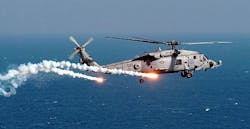Orbital ATK to upgrade and upgrade aircraft missile-warning systems in $30.7 million Navy contract
The AN/AAR-47 is an electronic warfare system that helps protect aircraft from heat-seeking and laser-guided missiles, as well as from unguided munitions by detecting incoming threats, warning the pilot, and dispensing countermeasures.
The AN/AAR-47 consists of electro-optical countermeasure sensors, countermeasure signal processors, and countermeasure signal simulators. The system is designed primarily for relatively slow-moving aircraft like helicopters and cargo jets.
Against infrared-guided missiles, the system automatically initiates countermeasures by sending a command signal to the countermeasures dispensing set, which deploys flares in attempts to confuse the missile's infrared guidance.
The contract, awarded by the Naval Air Systems Command at Patuxent River Naval Air Station, Md., calls for Orbital ATK to build, fix, and upgrade AN/AAR-47 assemblies for the U.S. Navy, Air Force, and Army, as well as for the governments of India, Norway, Spain, and Australia.
Orbital ATK was formed though the merger of Orbital Sciences Corp. and the aerospace and defense businesses of Alliant Techsystems (ATK). The merger was announced last April and closed this month.
AN/AAR-47 system offers multi-threat warning with sensor pre-processing for high-clutter environments. It is installed on Army, Air Force, Navy, and Marine Corps helicopters, the V-22 Osprey tiltrotor, the Air Force C-5, C-141, and C-17 cargo jets, the c-130 utility turboprop, and other aircraft.
The system interfaces with radar signal-detecting sets, countermeasures dispensing sets, multi-function cockpit displays, and pilot intercom systems.
The AN/AAR-47 has a computer processor that weighs about 16.25 pounds, a control indicator that weighs about 2 pounds, and optical sensor converters that weigh about 3.5 pounds each.
On this contract Orbital ATK will do 35 percent of the work for the Navy, 35 percent for the Air Force, 11 percent for Defense Working Capital funds, 10 percent for the National Guard and Reserve, 3.5 percent for India, 3.2 percent for Norway, 2 percent for Spain, and 0.3 percent for Australia.
Orbital ATK will do the work in Clearwater, Fla.; Austin, Texas; Quebec City; and other U.S. locations, and should be finished by April 2017.
For more information contact Orbital ATK online at www.orbitalatk.com, or Naval Air Systems Command at www.navair.navy.mil.
